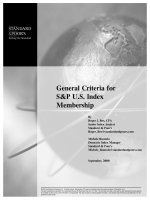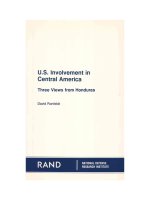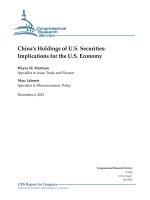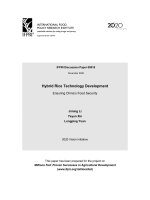U.S.-China Security Management ppt
Bạn đang xem bản rút gọn của tài liệu. Xem và tải ngay bản đầy đủ của tài liệu tại đây (406.55 KB, 129 trang )
This PDF document was made available
from
www.rand.org as a public service of
the RAND Corporation.
6
Jump down to document
Visit RAND at www.rand.org
Explore RAND Project AIR FORCE
View document details
This document and trademark(s) contained herein are protected by law
as indicated in a notice appearing later in this work. This electronic
representation of RAND intellectual property is provided for non-
commercial use only. Permission is required from RAND to reproduce, or
reuse in another form, any of our research documents.
Limited Electronic Distribution Rights
For More Information
CHILD POLICY
CIVIL JUSTICE
EDUCATIO
N
ENERGY AND ENVIRONMENT
HEALTH AND HEALTH CAR
E
INTERNATIONAL AFFAIR
S
NATIONAL SECURIT
Y
POPULATION AND AGIN
G
PUBLIC SAFETY
SCIENCE AND TECHNOLOGY
SUBSTANCE ABUSE
TERRORISM AND
HOMELAND SECURITY
TRANSPORTATION AND
INFRASTRUCTURE
The RAND Corporation is a nonprofit
research organization providing
objective analysis and effective
solutions that address the challenges
facing the public and private sectors
around the world.
Purchase this document
Browse Books & Publications
Make a charitable contribution
Support RAND
This product is part of the RAND Corporation monograph series.
RAND monographs present major research findings that address the
challenges facing the public and private sectors. All RAND mono
-
graphs undergo rigorous peer review to ensure high standards for
research quality and objectivity.
U.S China Security
Management
Assessing the Military-to-Military
Relationship
KEVIN POLLPETER
Prepared for the United States Air Force
Approved for public release; distribution unlimited
The RAND Corporation is a nonprofit research organization providing
objective analysis and effective solutions that address the challenges
facing the public and private sectors around the world. RAND’s
publications do not necessarily reflect the opinions of its research clients
and sponsors.
R
®
is a registered trademark.
© Copyright 2004 RAND Corporation
All rights reserved. No part of this book may be reproduced in any form
by any electronic or mechanical means (including photocopying,
recording, or information storage and retrieval) without permission in
writing from RAND.
Published 2004 by the RAND Corporation
1700 Main Street, P.O. Box 2138, Santa Monica, CA 90407-2138
1200 South Hayes Street, Arlington, VA 22202-5050
201 North Craig Street, Suite 202, Pittsburgh, PA 15213-1516
RAND URL: />To order RAND documents or to obtain additional information, contact
Distribution Services: Telephone: (310) 451-7002;
Fax: (310) 451-6915; Email:
Library of Congress Cataloging-in-Publication Data
Pollpeter, Kevin.
U.S.–China security management : assessing the military-to-military relationship /
Kevin Pollpeter.
p. cm.
“MG-143.”
Includes bibliographical references.
ISBN 0-8330-3536-3 (pbk. : alk. paper)
1. United States—Military relations—China. 2. China—Military relations—
United States. I.Title.
UA835.P59 2004
355'.031'09730951—dc22
2004004374
The research reported here was sponsored by the United States Air Force
under Contract F49642-01-C-0003. Further information may be
obtained from the Strategic Planning Division, Directorate of Plans, Hq
USAF.
iii
Preface
Controversy has surrounded the United States military-to-military
relationship with China ever since rapprochement began in 1971.
The current debate on Department of Defense activities with the
People’s Liberation Army (PLA) have focused attention on the value,
rationale, and benefits of the relationship. This study documents the
history of U.S. security management with China from 1971 to the
present and, based on that history, examines the arguments for and
against conducting certain types of activities with the PLA. It then
recommends a program of suitable military-to-military activities
based on prescribed constraints and goals.
The research reported here was sponsored by the Deputy Chief
of Staff for Air and Space Operations, U.S. Air Force (AF/XO), and
the Commander, Pacific Air Forces (PACAF/CC), and conducted in
the Strategy and Doctrine Program of RAND Project AIR FORCE.
The report should be of value to the national security community and
interested members of the general public, especially those concerned
with U.S. relations in the Asia-Pacific region. Comments are welcome
and should be sent to the project leader, James Mulvenon, or the
RAND Project AIR FORCE acting director of the Strategy and
Doctrine Program, Alan Vick:
James C. Mulvenon Alan Vick
1200 South Hayes St. 1200 South Hayes St.
Arlington, VA 22202 Arlington, VA 22202
(703) 413-1100 x5225 (703) 413-1100 x5253
U.S China Security Managementi
v
RAND Project Air Force
RAND Project AIR FORCE (PAF), a division of the RAND Corpo-
ration, is the U.S. Air Force’s federally funded research and develop-
ment center for studies and analyses. PAF provides the Air Force with
independent analyses of policy alternatives affecting the development,
employment, combat readiness, and support of current and future
aerospace forces. Research is performed in four programs: Aerospace
Force Development; Manpower, Personnel, and Training; Resource
Management; and Strategy and Doctrine.
Additional information about PAF is available on our web site at
/>v
The RAND Corporation Quality Assurance Process
Peer review is an integral part of all RAND research projects. Prior to
publication, this document, as with all documents in the RAND
monograph series, was subject to a quality assurance process to ensure
that the research meets several standards, including the following: The
problem is well formulated; the research approach is well designed and
well executed; the data and assumptions are sound; the findings are
useful and advance knowledge; the implications and recommendations
follow logically from the findings and are explained thoroughly; the
documentation is accurate, understandable, cogent, and temperate in
tone; the research demonstrates understanding of related previous
studies; and the research is relevant, objective, independent, and bal-
anced. Peer review is conducted by research professionals who were
not members of the project team.
RAND routinely reviews and refines its quality assurance process
and also conducts periodic external and internal reviews of the quality
of this body of work. For additional details regarding the RAND
quality assurance process, visit />
vii
Contents
Preface iii
Tables
ix
Summary
xi
Acknowledgments
xvii
Acronyms
xix
CHAPTER ONE
Introduction 1
CHAPTER TWO
Historical Context 5
Nixon and Ford Administrations
5
Carter Administration
7
Reagan Administration
11
George H. W. Bush and Clinton Administrations
14
George W. Bush Administration
25
Conclusion
27
CHAPTER THREE
Strategic Factors Affecting U.S China Security Relations 29
Global War on Terrorism (GWOT)
30
Taiwan
34
The Use of Force, Unilateralism, and “Hegemony”
35
China’s Response
36
U.S China Security Managementviii
CHAPTER FOUR
The U.S. Debate over U.S China Military Relations 43
Have U.S China Military Relations Harmed U.S. National Security?
43
Have Military Relations with China Benefited the United States?
47
U.S. Influence on the PLA
47
Reciprocity and Transparency
55
Poor Planning Leads to Poor Performance
69
Conclusion
72
CHAPTER FIVE
Chinese Views of Military Relationships 75
The Chinese Approach to Military Relations
80
Implications
82
CHAPTER SIX
Conclusion and Recommendations 87
Military Relations with the PLA: Worth the Trouble?
87
Designing an Effective Military Relationship with China
88
Constraints and Limitations
88
Program of “Security Management”
90
Improving the Process
96
Getting the PLA to Cooperate
97
Concluding Remarks
99
Bibliography
101
ix
Tables
4.1. Chinese Facilities Visited by U.S. Military Delegations 58
4.2. U.S. Facilities Visited by Chinese Military Delegations
61
xi
Summary
U.S China military relations are at an important crossroads. Because
of failures in the U.S China military relationship and the relation-
ship’s perceived lack of ability to produce tangible benefits, many ob-
servers have come to doubt its value and even argue that the relation-
ship has harmed U.S. national security. In 2001, the Defense
Department began a reassessment of its relations with the People’s
Liberation Army (PLA) to determine the extent and appropriate na-
ture of these contacts. This reevaluation of the U.S China military
relationship led to a severe curtailment in military-to-military activi-
ties. Since the EP-3 incident in April 2001, all military-to-military
activities with the PLA were reviewed on a case-by-case basis pending
the completion of a policy review. The few exchanges that do take
place are mainly military education exchanges and high-level dia-
logue. The completion of the policy review and the holding of De-
fense Consultative Talks in December 2002 have now opened the
door for military-to-military contacts to expand.
This report examines the debate surrounding U.S China secu-
rity cooperation and concludes that security cooperation between the
United States and China has value. Because of the possibility of
armed conflict over Taiwan, the United States needs to maintain a
military-to-military relationship with China. The military relation-
ship with the PLA is heavily constrained, however, in the benefits it
can provide the U.S. military. Consequently, conducting the type and
degree of military-to-military activities with the PLA that have been
conducted in the past is not appropriate. This study argues that the
xii U.S China Securit
y
Mana
g
ement
U.S. military-to-military relationship with China should not focus on
security cooperation. Instead, it should focus on security management
in which dialogue, information gathering, and limited cooperation
take place to minimize misperceptions and the chances of conflict.
Different Approaches
A significant hindrance in developing U.S China military relations is
the fundamentally opposite approach each side uses in pursuing co-
operative relationships. The U.S. military prefers a bottom-up ap-
proach in which lower-level contacts build trust and identify areas of
common interest. Once identified, these areas can be built upon with
more in-depth cooperation. The PLA, on the other hand, prefers a
top-down approach in which higher-level dialogue is employed to
build trust, which is a stepping stone to identify and reach areas of
agreement. Without this trust and agreement on strategic issues, the
PLA is uncomfortable with further enhancing cooperation.
U.S China military relations are also constrained by significant
policy differences between China and the United States over core se-
curity concerns, such as Taiwan and U.S. activism. The United States
remains wary of China’s refusal to renounce force to unify with Tai-
wan. China, for its part, resents the U.S. global force posture, use of
force, and continued military assistance to Taiwan, which are seen as
efforts to undermine China’s sovereignty and security. As a result of
these policy differences, each side regards the other side as a potential
enemy. Consequently, the PLA has been reluctant to be equally
transparent in its relations with the U.S. military, despite agreement
on military-to-military activities at the presidential level. (See pages
80–86.)
Four Issues of Contention
The current debate in the United States on U.S China military rela-
tions has centered around four major issues of contention: the poten-
Summary xiii
tial risk of U.S China military relations to U.S. national security, the
potential benefits of the U.S China military relationship to the
United States, the ability of the United States to influence China, and
the relative levels of reciprocity and transparency in the relationship.
Benefits for the PLA?
Whether the PLA has benefited from its relationship with the U.S.
military can largely be determined only through inference. Much in-
formation about U.S. military strategy and doctrine is available from
open sources, including the Internet, making it entirely possible that
considerable PLA knowledge of the U.S. military has come from a
massive translation effort that has disseminated U.S. writings widely
within the organization. It is also possible, however, that questions
asked by PLA delegations to their U.S. interlocutors could have pro-
vided greater insight or cleared up misperceptions regarding U.S. doc-
trine. An additional measure of whether the PLA benefits from its
interactions with the U.S. military is its own opinion of the value of
the relationship. The PLA reportedly values its relationship with the
U.S. military because it can draw lessons on how it should conduct
reform. Thus, it must be assumed that the PLA has benefited to some
extent from its relationship with the U.S. military. (See pages 43–47.)
Benefits to the United States?
In contrast, some observers contend that the U.S. military has not
benefited from its relationship with the PLA because of the latter’s
penchant for secrecy and deception. Again, it is difficult to assess
from open sources the benefit of the relationship for the U.S. mili-
tary. Interlocutors, however, have provided specific examples of in-
stances where information was gathered on the PLA through delega-
tion visits or through the normal function of the attaché office,
indicating that the U.S. military has benefited to some extent from its
relationship with the PLA. (See page 47.)
Military-to-Military as a Tool of Influence?
A case study examination of the U.S China relationship in regard to
military-to-military relations, intellectual property rights, and arms
xiv U.S China Securit
y
Mana
g
ement
control and nonproliferation indicates that the United States has
limited influence over China. Influence over China has been better
achieved with economic incentives and disincentives and interna-
tional pressure than with unilateral U.S. pressure. The use of these
measures within the military-to-military context appears inappropri-
ate, however. Thus, a look at the evidence from several cases suggests
that the U.S. military has very little influence over the PLA and the
Chinese government. China is more influenced by international
opinion than by U.S. pressure alone; economic incentives and disin-
centives have had a measured success in changing Chinese behavior;
and the military relationship does not exist in a vacuum, but instead
is primarily shaped by the tenor and atmosphere of the overall politi-
cal and diplomatic relationship. (See pages 47–55.)
Reciprocity and Transparency
The most contentious issue is that of reciprocity and transparency.
Chinese officials have long resisted efforts at greater transparency, ar-
guing that “transparency is a tool of the strong to be used against the
weak.” For its part, the United States can be said to want transpar-
ency at the operational level whereas China wants transparency at the
strategic level.
Thus, until China is comfortable with U.S. strategic
intentions, significant obstacles to reciprocity will continue to exist.
While all interlocutors agree that there is a gap in transparency be-
tween the U.S. military and the PLA, there is disagreement over its
degree and significance. Analysis of military exchanges indicates that
the discrepancy over reciprocity and transparency does not revolve
around the types of bases visited and the frequency of visits; rather it
revolves around the U.S. military not being shown operational train-
ing or realistic exercises, to which the PLA has had access, and to the
content of functional
1
visits. In addition, inefficiencies in the U.S.
Defense Department’s handling of its military relations with the
PLA—inefficiencies in planning, conducting, and debriefing—have
_____________
1
Functional refers to facility visits, student exchanges, and discussions of professional mili-
tary topics. Activities are usually conducted between mid-level officers and officials.
Summary xv
limited the U.S. military’s ability to properly exploit PLA transpar-
ency when it exists. (See pages 55–57.)
Overall Assessment and Policy Recommendations
Despite the problems encountered with carrying out the U.S China
military relationship, there is value in continuing these activities. Al-
though limitations in transparency and influence exist, the possibility
of armed conflict between the United States and China warrants that
a relationship be maintained to resolve differences and avoid misper-
ceptions. This analysis recommends a three-part program of commu-
nication, information gathering, and limited cooperation. Communi-
cation can be conducted at the highest levels to signal strategic intent,
clarify policy, and attempt to dissuade and deter China from taking
actions inimical to U.S. interests. The relationship can also be used to
gather information on the PLA to improve the U.S. military’s under-
standing of PLA operations, doctrine, and role in the Chinese gov-
ernment. Finally, limited cooperation can take place when U.S. inter-
ests are at stake. Cooperation in the war against terror may be one
prime example. Functional exchanges, however, like those conducted
in the past to improve understanding will probably fail because of the
lack of trust engendered by disagreements over strategic intent. (See
pages 90–99.)
xvii
Acknowledgments
The author would like to thank the many people who were generous
in freely giving their time to discuss U.S China military relations.
They all provided valuable information and insights into the
relationship. Because of the highly politicized nature of the issue, all
prefer to remain nameless.
The author thanks James Mulvenon for his guidance in
organizing the report, David Adamson, Eric Valko, and Jeanne Heller
for their excellent editing of an early draft, and Heather Roy for
valuable administrative support throughout the endeavor. He also
thanks reviewers Roger Cliff and David Finkelstein for their
comments and Jonathan Pollack and William Rosenau for their
comments on an early version of this paper that will appear as a
chapter in a larger volume on U.S. security cooperation in Asia.
xix
Acronyms
ABM Anti-Ballistic Missile (Treaty)
BWC Biological Weapons Convention
CINCPAC Commander-in-Charge, Pacific
CNA Center for Naval Analyses
COCOM Coordinating Committee for Multilateral Export
Controls
CTBC Comprehensive Test Ban Treaty
CWC Chemical Weapons Convention
DCT Defense Consultative Talks
ETIM East Turkestan Islamic Movement
FPE Functional and Professional Exchanges
GWOT Global War On Terrorism
IPR Intellectual Property Rights
U.S China Security Managementxx
IRBM Intermediate Range Ballistic Missile
MMCA Military Maritime Consultative Agreement
MTCR Missile Technology Control Regime
NDAA National Defense Authorization Act
NDU National Defense University
NPR Nuclear Posture Review
NPT Nuclear Nonproliferation Treaty
OSD Office of the Secretary of Defense
PLA People’s Liberation Army
PRC People’s Republic of China
PRM Presidential Review Memorandum
QDR Quadrennial Defense Review
RMA Revolution in Military Affairs
SALT Strategic Arms Limitation Treaty
SSGN Guided Missile Nuclear Submarine
USCINCPAC United States Commander in Charge, Pacific
WTO World Trade Organization
1
CHAPTER ONE
Introduction
This report addresses the debate concerning U.S China military rela-
tions. Specifically, it examines the goals of U.S. policy, assesses the
benefits of the current relationship, and proposes a revised policy
based on a realistic assessment of what such a relationship can ac-
complish. It also reviews the history of U.S China military relations,
particularly the transition from cooperation in support of a strategic
rationale to cooperation to form a strategic rationale, and recom-
mends a future military relations program based on U.S. and Chinese
goals and the constraints placed on military-to-military activities by
both sides.
The report argues that the fundamental reason for the instability
in military-to-military ties with the People’s Liberation Army (PLA)
has been the pursuit of specific policies by each government that are
perceived by each to be inimical to its respective interests. The rela-
tionship has thus been affected by the stances of the two countries
over Taiwan and differences in overall strategic intent.
The distrust engendered by the pursuit of these policies has re-
sulted in each side viewing the other as a potential enemy. Because of
the potential for armed conflict between the United States and
China, and because China is the weaker power, the PLA has been re-
luctant to share even the most basic information with the U.S. mili-
tary in a belief that it has more to lose than the United States by be-
ing open. Thus, the PLA has been a reluctant partner in many
U.S China Security Management2
activities with the U.S. Defense Department, resulting in limited
benefits to the United States.
However, bureaucratic inefficiencies within the U.S. Defense
Department have also limited the benefits of military-to-military ac-
tivities with the PLA. Uncoordinated planning, execution, and de-
briefing as well as a lack of qualified China analysts directly leveraging
access to the PLA have hindered the U.S. Defense Department’s abil-
ity to identify, exploit, and assess the information it has gathered
from its relationship with the PLA.
While the perceived lack of tangible benefits has led many ob-
servers to question whether the United States should have a military
relationship with China, the sometimes contentious nature of U.S
China relations and the possibility of armed conflict with China over
Taiwan warrants that lines of communication should remain open to
avoid misunderstandings and resolve misperceptions. Consequently,
what in the past consisted of efforts to engage in security cooperation
with China should now be better described as “security manage-
ment.” Such a program would consist of activities to manage the rela-
tionship so that it can prevent conflict, while taking into account the
constraints and limitations present in the relationship. Specifically,
this report recommends curtailing functional activities,
1
long compli-
cated by disagreements over reciprocity and transparency, and instead
focusing on high-level dialogue that will enable both sides to com-
municate policy and concerns and resolve misperceptions. In addi-
tion, it recommends that the U.S. Defense Department appoint a
person (either civilian or military) with sufficient rank to reform the
internal processes that it uses to manage military-to-military activities
with the PLA.
The next chapter reviews the historical context of U.S China
security cooperation from 1971 to the present and offers a short
analysis of the difficulties inherent in the relationship. The chapter
posits that the main issues dividing China and the United States have
not been resolved and still affect the relationship today.
_____________
1
Functional refers to facility visits, student exchanges, and discussions of professional mili-
tary topics. Activities are usually conducted between mid-level officers and officials.
Introduction 3
Chapter Three examines the current security environment be-
tween the United States and China and its implications for military-
to-military relations. It concludes that there are numerous issues that
hinder the development of a healthy relationship between the United
States and China, but that these issues do not obviate the value of
continuing contacts.
Chapter Four explores the debate surrounding military relations
with the PLA and assesses the validity of the arguments. It observes
that the PLA has been less open and has permitted less access to its
facilities than has the U.S. military and concludes that to a limited
extent Washington has been harmed by its military relationship with
Beijing, whereas China has benefited somewhat from its military rela-
tionship with the United States.
Chapter Five examines PLA attitudes toward military relations
with the United States. It reveals that the U.S. military and the PLA
conduct relationships in fundamentally different ways. The PLA pre-
fers a top-down approach, in which prior understanding of strategic
issues can be operationalized at lower levels. The U.S. military, on the
other hand, prefers a bottom-up approach that emphasizes identify-
ing areas of cooperation through the implementation of activities at
the working level. This fundamental difference has led the United
States to propose activities that have not been fully supported by the
PLA.
Chapter Six sets out the constraints imposed on the relationship
by both the United States and China, assesses their impact on mili-
tary-to-military activities, proposes a set of goals for these activities,
and then recommends a course of action.









